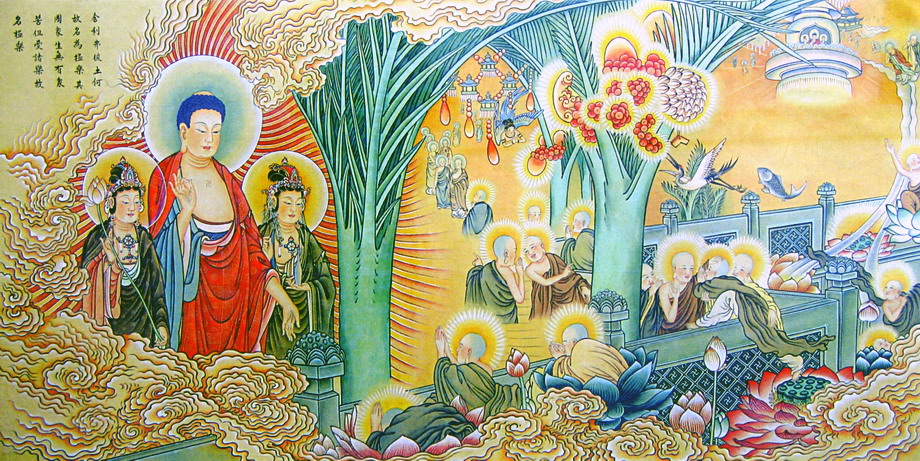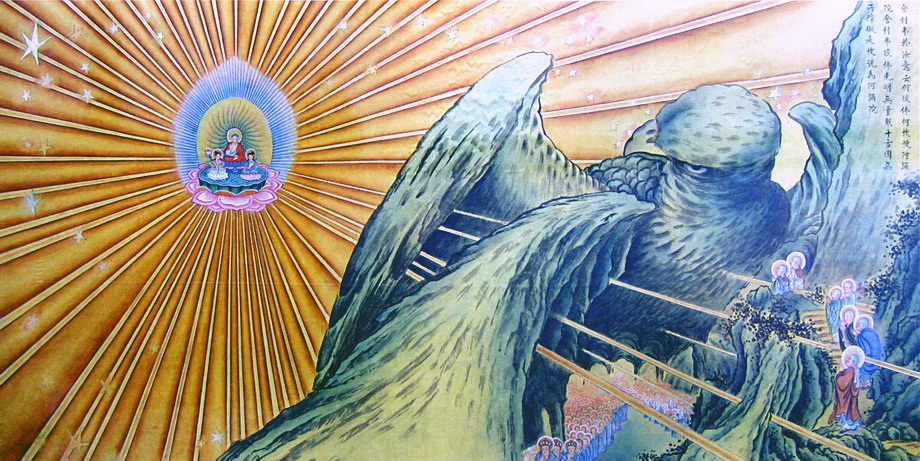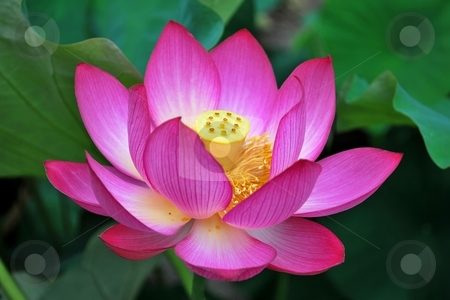THE SIXTH PATRIARCH’S DHARMA JEWEL PLATFORM SUTRA
A Commentary by the Venerable Master Hsuan Hua
Chapter 9
PROCLAMATIONS
Sutra:
On the fifteenth day of the first month, during the first year of the Shen Lung reign (A.D. 705) Empress Tse T’ien and Emperor Chung Tsung issued the following proclamation:
“We have invited Masters Hui An and Shen Hsiu to the palace to receive offerings so that we may investigate the One Vehicle in the leisure time remaining after our myriad duties. The two Masters have declined, saying that in the South there is Dhyana Master Hui Neng, who was secretly transmitted the robe and Dharma of the Great Master Hung Jen who now transmits the Buddhas’ mind-seal.
“We now send Chamberlain Hsieh Chien with this invitation, hoping that the Master will remember us with compassion and come to the capital.”
The Master sent back a petition pleading illness saying that he wished to spend his remaining years at the foot of the mountain.
Commentary:
The Ninth Chapter is entitled “Proclamations.”
Wu Tse T’ien was an empress during the T’ang dynasty. She believed in the Buddha, but she wasn’t very orthodox. In fact, she would do anything. But she believed in Buddhism and so she invited all the high monks to the palace to receive offerings.
Her son, Emperor Chung Tsung, reigned only a short time before the empress had him exiled to Lu Ling to be king there, so that she could take the throne.
A proclamation was a letter from the emperor. When ordinary people received a proclamation, they bowed to it as a gesture of respect to the emperor, but people who have left home don’t do this, of course.
Wishing to study the One Buddha Vehicle, the Sudden Teaching Dharma door, the empress invited Masters Hui An and Shen Hsiu to come to the palace to receive offerings. But they refused. “We do not have enough virtue,” they said, “You should invite Hui Neng. He has received the Fifth Patriarch’s robe and bowl and is a true transmitter of the mind seal.”
The empress took the two masters’ advice and invited the Sixth Patriarch to the capital, Ch’ang An. The invitation was brought by a chamberlain, that is, by an official of the inner court. The chamberlain, Hsieh Chien, was a eunuch. Eunuchs began serving Chinese emperors during the Han dynasty.
The Sixth Patriarch wrote back “I am very ill.” Actually, he wasn’t ill at all; this was merely an expedient device, because the Sixth Patriarch did not wish to visit a ruler. More specifically, he did not wish to visit an empress. It would have been against the rules. Wu Tse T’ien knew nothing about moral precepts and she didn’t follow any rules. But the Sixth Patriarch couldn’t say, “You are an empress and I am a Patriarch and I don’t have to visit you,” so he said, “I am old and sick.”
Sutra:
Hsieh Chien said, “The Virtuous Dhyana Masters at the capital all say that to master the Way one must sit in Dhyana meditation and practice concentration, for without Dhyana concentration, liberation is impossible. I do not know how the Master explains this dharma.
The Master said, “The Way is awakened to from the mind. How could it be found in sitting? The Diamond Sutra states that to say that Tathagata either sits or lies down is to walk a deviant path. Why? The clear pure Dhyana of the Tathagata comes from nowhere and goes nowhere and is neither produced nor extinguished. The Tathagata’s clear pure ‘sitting’ is the state of all dharmas being empty and still. Ultimately there is no certification; even less is there any ‘sitting.’”
Commentary:
For an illiterate, the Master was quite intelligent. He answered, “You awaken to the Way from within your mind. You can’t just sit there. You have to understand the principles of the Buddhadharma and be enlightened to them. The enlightenment is ‘understanding’ and the sitting is ‘practice.’ Practicing without understanding is stupid; understanding without practice is nothing but intellectual zen.”
You must understand and practice. Don’t just sit, sit, sit for several decades without even understanding the principle of enlightening your mind.
The Master added, “Since ultimately there is nothing to be attained or certified to, why be attached to sitting in meditation?”
Sutra:
Hsieh Chien said, “When your disciple returns to the capital, their majesties will surely question him. Will the High Master please be compassionate and instruct me on the essentials of the mind so that I can transmit them to the two palaces and to students of the Way at the capital? It will be like one lamp setting a hundred thousand lamps burning, making all the darkness endlessly light.”
The Master said, “The Way is without light or darkness. Light and darkness belong to the principle of alternation. ‘Endless light’ has an end, too, because such terms are relative. Therefore the Vimalakirti Sutra says, ‘The Dharma is incomparable because it is not relative.’”
Hsieh Chien said, “Light represents wisdom and darkness represents affliction. If cultivators of the Way do not use wisdom to expose and destroy affliction, how can they escape from the birth and death that have no beginning?”
The Master said, “Affliction is Bodhi; they are not two and not different. One who uses wisdom to expose and destroy affliction has the views and understanding of the two vehicles and the potential of the sheep and deer carts. Those of superior wisdom and great roots are completely different.”
Hsieh Chien said, “What are the views and understanding of the Great Vehicle?”
The Master said, “The common person sees light and darkness as two, but the wise person comprehends that their nature is non-dual. The non-dual nature is the real nature. The real nature does not decrease in common people nor increase in worthy sages. In afflictions it is not confused and in Dhyana concentration it is not still. It is neither cut off nor permanent. It does not come or go. It is not inside, outside, or in the middle. It is not produced or destroyed. The nature and mark is ‘thus, thus.’ It permanently dwells and does not change. It is called the ‘Way.’”
Commentary:
Hsieh Chien wished for instruction on the essentials of the principle of using the mind to seal the mind. He said that the Patriarch was like a lamp, setting a hundred thousand lamps burning in the capital: bright, bright limitless light.
The Master said, “You shouldn’t see light and darkness as different or affliction and Bodhi as different. Affliction and the enlightenment nature are one. Shravakas and Pratyekabuddhas destroy affliction by means of wisdom, but Buddhas and Bodhisattvas are completely different from them. Ordinary people see understanding and ignorance as two, but wise people know that in essence they are one, not two. That non-dual nature is the real nature. In states of confusion, the real nature is not confused; in Dhyana concentration, it is not still. It is both still and moving; it both moves and is still. The nature and mark are both ‘thus’. We call it the ‘Way.’”
Sutra:
Hsieh Chien said, “How does your explanation of the self-nature as neither produced nor destroyed differ from that of other religions?”
The Master answered, “As non-production and nonextinction are explained by other religions, extinction ends production and production reveals extinction. Their extinction is not extinction and what they call production is not production. My explanation of non-production and non-extinction is this: originally there was no production and now there is no extinction. For this reason my explanation differs from that of other religions.
“If you wish to know the essentials of the mind, simply do not think of good or evil. You will then enter naturally the clear, pure substance of the mind, which is deep and permanently still, and whose wonderful abilities are as numerous as the sand grains in the Ganges River.”
Commentary:
Other religions see production and extinction as two. They say that extinction puts an end to production and that production reveals extinction. Their explanation is not the ultimate one. As I explain the terms, originally there was no production, and so now there is no extinction.
The Master continued, “If you would like to know about the wonderful mind-transmission Dharma, the essential points of the mind-ground Dharma door, I will tell you: simply do not think of good or evil. Then you will spontaneously understand the true principle and enter into the pure substance of the mind.” The mind-substance is deep and constantly pure and still. Although it is always still, within its true emptiness there is wonderful existence, and its wonderful abilities are innumerable.
Sutra:
Hsieh Chien received this instruction and was suddenly greatly enlightened. He bowed, took leave, and returned to the palace to report the Master’s speech. That year on the third of the ninth month a proclamation was issued in praise of the Master. It read:
“The Master has declined our invitation because of old age and illness. He cultivates the Way for us and is a field of blessings for the country. The Master is like Vimalakirti who pleaded illness in Vaishali. He spreads the great fruit widely, transmitting the Buddha-mind and discoursing on the non-dual Dharma.
“Hsieh Chien has conveyed the Master’s instruction, the knowledge and vision of the Tathagata. It must be due to accumulated good acts, abundant blessings, and good roots planted in former lives that we now have met with the Master when he appears in the world and have suddenly been enlightened to the Supreme Vehicle. We are extremely grateful for his kindness which we receive with bowed heads, and now offer in return a Mo Na robe and crystal bowl as gifts. We order the Magistrate of Shao Chou to rebuild the temple buildings and convert the Master’s former dwelling place into a temple to be called ‘Kuo En,’ (Country’s Kindness).”
Commentary:
Hsieh Chien returned to the capital and submitted a written report to the empress which set forth the principles the Master had discussed with him. The palace then issued a statement in praise of the Master, saying he was the highest Master in the nation and one of unexcelled cultivation. They said that the Sixth Patriarch was like the layman Vimalakirti, who was sick in Vaishali.
“The Master propagates the ‘great fruit,’ the Mahayana Buddhadharma, and transmits the ‘Buddha-mind,’ the mind-seal of all Buddhas. At Nan Hua Temple he expounds the non-dual Dharma door, saying that production and extinction are one and the nature and mark are not two. His knowledge and vision are that of the Buddha. We must have done a lot of good things in past lives in order to meet the Master now and suddenly awaken to the wonderful principle of the Supreme Vehicle. We bow to his teaching every day and hold it respectfully above our heads.”
They offered the Master an expensive robe made of Korean cloth which had been sent as tribute to the empress. It was a patchwork robe, with a Buddha image embroidered on each patch. Some say that the empress embroidered them herself, but there is no way to know with certainty.





